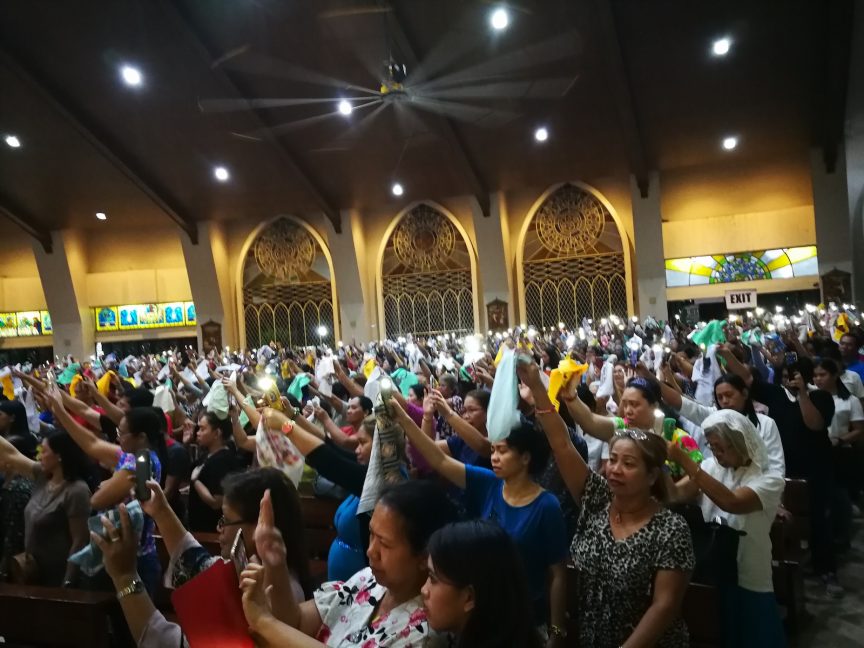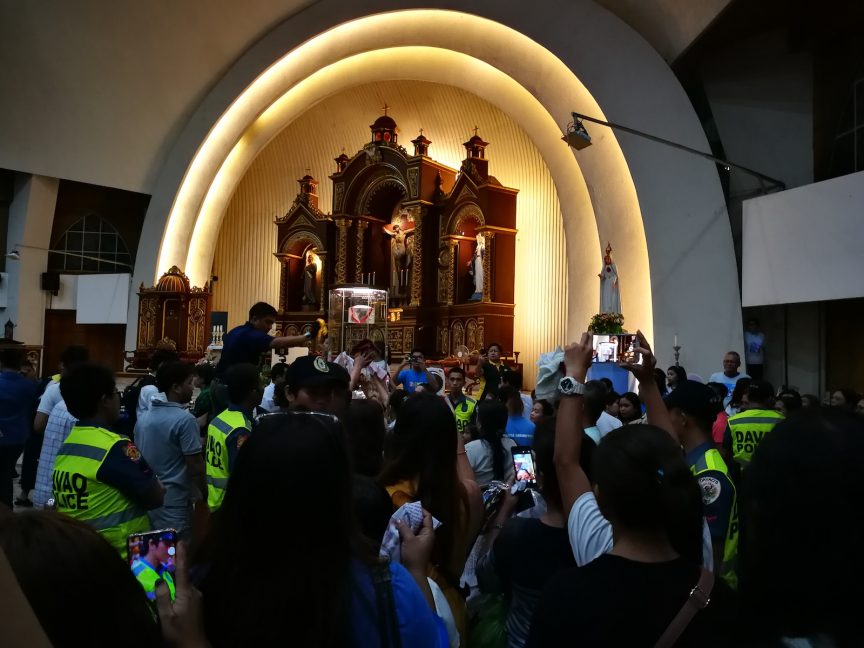 Devotees raise their handkerchiefs and mobile phones for the pray over before the last public veneration on Tuesday night, Oct. 16, 2018, at San Pedro Cathedral in Davao City. MindaNews photo by ANTONIO L. COLINA IV
Devotees raise their handkerchiefs and mobile phones for the pray over before the last public veneration on Tuesday night, Oct. 16, 2018, at San Pedro Cathedral in Davao City. MindaNews photo by ANTONIO L. COLINA IV
DAVAO CITY (MindaNews/ 17 Oct) – Hundreds trooped to San Pedro Cathedral on Tuesday, the last night of the public veneration of Padre Pio’s incorrupt heart relic in Davao City, where Mati Archbishop Abel Agipo urged Catholics to remember the once-in-a-lifetime visit not only as a memory on social media but also as testament to their strong faith in God.
In his 15-minute sermon, Agipo told the devotees that the heart relic of Padre Pio, an Italian priest and mystic known for the gift of stigmata or the wounds of Christ, should remind them to keep their hearts “beating with faith and with deep trust in God.”
A number of devotees were quick to snap their photos while approaching the glass-encased relic, displayed just before the church altar, sometimes blocking the way of other people who patiently waited for their turn to wipe the relic with their handkerchiefs painted with Padre Pio’s image.
Agipo hopes the event will not only remind the devotees of “memories of our selfies, memories of our Instagram, memories of our Twitter but also as a religious memory” as they look back to the four-day visit of the relic.
The heart relic arrived on Sunday from Cebu and was brought to Ateneo de Davao University-Matina Campus for Eucharistic celebration and veneration. The Archdiocese of Davao is the fourth destination of its 22-day visit in the country, the longest of its foreign visits.
The relic stayed for four days in Davao and would be brought to the Archdiocese of Lipa in Batangas on Wednesday morning and leave the country on October 26.
A predominantly Catholic nation, the Philippines is the fourth country visited by the relic this year and the first in Asia. The relic, a national treasure of the Italian government, visited the US, Argentina and Portugal this year.
Nisa Risa and son Miguel lined up for three hours outside the church. The mother prayed to strengthen her faith while her son asked for good health and better life through the intercession of the saint.
Merlita Robles, 56, a mother of three, made sure to venerate Padre Pio at the cathedral before reporting to work at 9 p.m. at the Public Safety and Security Command Center.
Robles asked for the intercession of Padre Pio for recovery from a cardiovascular disease. She was diagnosed with the disease when she was just 8 months old.
“I came here because we might not get the chance to experience something like this again,” she said.
Agipo said Padre Pio, born Francesco Forgione, lived a virtuous and holy life, a good example of someone who demonstrated a strong faith in God and helped the church survive a number of imperfections and kept the faith of its followers very much alive.
Padre Pio was chosen as the “good model” for the Catholic Bishops Conference of the Philippines’ (CBCP) declaration of 2018 as the “Year of Clergy and Consecrated Persons” because he was a priest and a member of the Order of Friars Minor Capuchin.
The CBCP initiated its visit with the National Shrine of Saint Padre Pio Batangas.
 Devotees surround the glass-encased heart relic of Saint Padre Pio inside the San Pedro Cathedral in Davao City on Tuesday, 16 Oct. 2018. MIndaNews photo by ANTONIO L. COLINA IV
Devotees surround the glass-encased heart relic of Saint Padre Pio inside the San Pedro Cathedral in Davao City on Tuesday, 16 Oct. 2018. MIndaNews photo by ANTONIO L. COLINA IV
“The holy heart of Saint Padre Pio is set to leave, but our life’s mission will continue, that is to strive for holiness. We have a model in our contemporary time. We have Saint Padre Pio who showed us to be compassionate, to be loving to God, and to be faithfully proclaiming the Gospel of God,” Agipo said.
Padre Pio died in 1968 and was canonized by Pope John Paul II in 2002.
Agipo was amused by the persistence of the devotees who visited the cathedral, to venerate Padre Pio’s heart relic despite having to brave the long queues, afternoon heat, and heavy downpour for two consecutive nights since Monday.
The prelate hopes the relic’s visit will strengthen the bond of the Catholics with the church as they celebrate the 500th anniversary of the arrival of Christianity in the Philippines on March 16, 2021.
It was on March 16, 1521 that Ferdinand Magellan, a Portuguese explorer, arrived in the archipelago and claimed it in the name of Spain.
“We saw that there were long queues. Instead of getting fewer – because Christianity is too old a religion — it’s the reverse. People continue to manifest their religiosity and their faith,” Agipo said.
He added the Filipinos’ popular religiosity “is our proclamation that our faith is alive.”
“Holiness is the most attractive face of the church. Let the face of holiness be seen in our individual lives that Christian faith may always and always be lived and shared by all of us,” he said.
Many of the devotees came to the cathedral as early as 4 p.m. on Tuesday. The church gates had been closed to the public by 5 p.m. as the cathedral was already full of parishioners waiting for the start of the 5:30 p.m. eucharistic mass.
Fr. Ilde Dimaano, social communications director of the Archdiocese of Lipa and representative of the National Shrine of Saint Padre Pio in Batangas, said half of the priest’s heart was discovered to have been preserved when his body was exhumed following the miraculous events allegedly as a result of the people’s devotion, 40 years after he died.
Many believed it could have been a result of transverberation of the heart that he experienced at one point in his life as a “reward by God for loving him.” (Antonio L. Colina IV/MindaNews)
